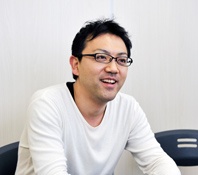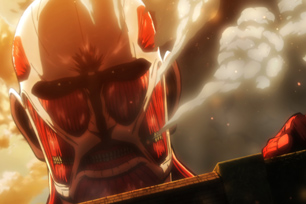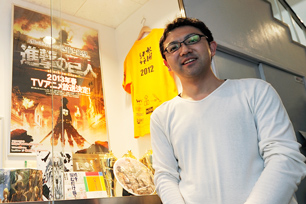George Wada, Co-founder and President, WIT STUDIO, Inc., Producer
Producer of Shingeki no Kyojin
Switched from the IT industry, wanting to create something Japanese that can be recognized worldwide
In 2012, founds an animation production company

George Wada,
Co-founder and President, WIT STUDIO, Inc., Producer
Born in Hyogo Prefecture in 1978. Graduated from the Faculty of Law in 2001. Wada started his career at Cisco (Cisco Systems G.K.), and in 2005, joined Production I.G., an animation production company. He served as producer of series such as Sengoku Basara and Guilty Crown. In 2012, he founded WIT STUDIO with colleague Tetsuya Nakatake, and became president. The company attracts a lot of attention as it has produced animation of Shingeki no Kyojin (English title: Attack on Titan), a popular manga series, despite being a newcomer in the industry of animation production.
First work after becoming independent was animation production of Shingeki no Kyojin

─ Shingeki no Kyojin (English title: Attack on Titan) is a popular manga series written and illustrated by Mr. Hajime Isayama, serialized in Kodansha’s Bessatsu Shonen Magazine. The series, which has become a huge success with a total of over 36 million volumes of comic books sold, is about mysterious gigantic “titans” that attack and devour humans, and main characters that fight against them.
Mr. George Wada is the president of WIT STUDIO, which made the series into animation, and served as producer in animation production. To start with, please tell us how you got involved in animation of the series.
WIT STUDIO is an animation production company that was founded only 2 years ago. Our first work was the production of Shingeki no Kyojin which was released last year. When I read the original manga, I felt a strong desire to produce an animation, so jointly with Pony Canyon, we went to Kodansha and proposed the series to be made into animation. We gave a presentation, emphasizing that we will “gather the best staffs” for production, starting with Tetsuro Araki as director. Kodansha also had a strong desire to produce the animation with quality staff, so they accepted our offer.
─ So the animation of Shingeki no Kyojin realized because you proposed it. Did the production go smoothly?
There were 25 episodes in all, and every time, we could barely make it for the airdate. So for the last few episodes, I would take the freshly made tape, hop on an airplane to deliver it to TV stations around the nation. This was a really tough job, as I had to repeat it every week.
In production, the person in charge at Kodansha would sometimes be quite demanding, only because of his passion for the series. This was actually a fortunate thing, because the willingness of the staffs to somehow respond to his passion helped upgrade the quality of the animated pieces.
─ They are certainly excellent. What’s more, the quality gets better and better with each episode.
Every time an episode was aired, the impact was amazing on Twitter and etc., and it motivated us because we wanted to respond to their expectations and wanted the audience to enjoy. We may have heightened our hurdles by ourselves. Another important aspect is that Mr. Isayama helped create the animation with us almost like he was a staff.
The characters in the story live behind high walls that surround the town. The setting and story of Shingeki no Kyojin, which describes the battle between creepy titans that attack on people and young humans who fight against them, won the sympathy of young people around the world who have anxiety over the competitive society and political situation. The “inner side of the wall” is described fabulously as a metaphor of today’s society. Mr. Isayama’s unique sensitivity and way of seeing the world is just awesome.
─ You used to belong to another animation production company before deciding to found your own company, but how did it happen?
Before becoming independent, I belonged to Production I.G, which has been making many manga into animation, including Ghost in the Shell / Kokaku Kidotai which became a worldwide success.
I served for the company for 7 years, but felt that I did everything I could as an in-house producer, and decided to found a company with Mr. Tetsuya Nakatake, one of my colleagues. When I went to report this to Mr. Mitsuhisa Ishikawa, president of the company, he asked me whether my main focus was to found a company or focus on production. I answered “production”, and he said, “Well then, why don’t you start a company as our affiliate, so that you can produce whatever you want. The industry is getting tough, and companies need to be financially strong, so I will also invest for the company.” This was really unexpected, but I felt grateful and accepted the offer, so with the additional capital on top of my personal funds, we got to found our own company. This resulted in creating an environment where we can concentrate on producing high quality pieces, and I feel it was a really good thing that we could start as a group company.
My job title is president, but what I am actually doing is production, which is to gather “people, material and money” and take responsibility in producing animations. I gather staffs, and when there is an original piece, we aim at receiving approval for production, and as for our original pieces, we plan them ourselves. Then I gather capital enough to produce the piece.
─ At WIT STUDIO, you also produced an original theatrical animated film titled Hal (released June 2013, DVDs and Blue-Rays now available in stores). This is a story of a girl who lost her boyfriend opens out to a robot that looks just like him, and regains her smile.
Based on our corporate strategy, we produced two different pieces to show our flexibility and to avoid fixing our company image. Just as first impression is important in person-to-person encounters, the first piece of an animation production company is very important. I thought that whether our new company can receive recognition or not depended on our first piece.
The animation industry is a world with very few winning patterns, and although there is a way to “create pieces with strong character for a very small and limited target,” this is starting to become difficult in Japan because of the declining younger population. In order to be successful in this industry from now on, I think there are only two ways, “a piece that gains international recognition” or “an original piece that can be enjoyed with the whole family” just like Ghibli. Therefore, we decided to produce Shingeki no Kyojin as a world-class piece, and Hal as an original piece that can be enjoyed with the whole family. As a result, we are lucky enough to be able to handle a wide range of productions today.
Now that I founded my own company, I have complete control of “what to produce”, and this freedom that allows me to do anything is so exciting. I would like to keep producing pieces that have a unique taste as WIT STUDIO, different from Ghibli or I.G.
─ Since you just mentioned the name Ghibli, what feelings do you have for directors such as Hayao Miyazaki and Isao Takahata, who are senior players in the animation industry?
They are truly great forerunners. They deserve respect because they spread and made the world recognize the unique sensitivity and philosophy of the Japanese through animation, something much deeper than just fun or enjoyable, also including our view of life and death. I think Shingeki no Kyojin that we produced was easily accepted worldwide because the grammar of animation had already permeated the world, cultivated by our forerunners.
─ You studied at the Faculty of Law, but were you interested in animation production since you were a student?
No way, my aim was to become a lawyer until third-year. One day as part of a class, we had the opportunity to listen to speeches by business people. After attending a trial session, a lawyer said, “Just like today’s trial, 95% of my life is about arbitrating disputes. Can you students bear that?” I felt I am not fit for it (laughs), so I changed direction to seeking a career in private corporations. That is why I joined Cisco Systems, an international company.
─ Cisco is a company that develops and sells computer network devices, as well as providing related services.
The IT industry around the year 2000 was still chaotic and seemed interesting. Also, I used to go to the Shonan Fujisawa Campus from Mita Campus to attend lectures of Professor Jun Murai (presently Dean of the Faculty of Environment and Information Studies), known as the “father of internet in Japan”, which may have influenced my decision. I became friends with those who knew a lot about computers, and I also enjoyed the liberal atmosphere of SFC, and felt that although the path is not fixed yet, everything looks interesting, so I did not have any feeling of resistance or prejudice about joining an international company.
Transferred to the animation industry, wanting to create a Japanese product that responds to the world’s demands


─ Why did you switch to the world of animation from IT?
The desire to sell something Japanese and of high quality to the world motivated me. At Cisco, we would sell products developed by the U.S. headquarters to Japanese companies. Through communication with customers, we would come across all kinds of customer needs such as user-friendliness. We would send feedback to the headquarters, but since these are needs unique to the Japanese market, Cisco that works under a global standard usually wouldn’t take in our requests. Since the company operates on a global scale, they may had little choice, but little by little, I started to question this situation, and came to think that I want to do a job that would serve as the opposite, meaning selling original Japanese products for the global market.
However, a liberal arts graduate like me doesn’t have the knowledge or technique of engineering to design an industrial product. When I was wondering what could be possible for me, I met Mr.Ishikawa, president of Production I.G. I had the opportunity to talk to Mr. Ishikawa who was a lecturer at a seminar, and felt that since Japanese culture is well accepted abroad, I might be able to realize my wish with animation. That is why I joined Production I.G. My desire to carefully create something and to deliver quality products to everyone hasn’t changed since my days at Cisco.
─ So now that this goal is achieved, what is your outlook for the future?
The imaging industry itself is starting to change significantly, and we are now in a phase where producers should take responsibility in managing their intellectual properties. We also are considering making more efforts in rights management. The basic and most important step is “signing contracts”. In occasions such as selling our work overseas or joint production with a foreign company, my knowledge about contracts that I acquired at the Faculty of Law is helping me a lot.
─ So you are being able to take advantage of what you learned in university. Could you tell us about your memories during your college days?
I used to always hang around at the dormitory in Hiyoshi Campus. I used to live in an apartment, but I had a friend who lived in the dormitory, so I would visit him quite often. We would talk forever about all kinds of things, such as about our future and dreams. Which reminds me of the smell inside the elevator, it always smelled like “sento” (public bath), maybe coming from the students who had just got out of the large bath (laughs).
─ Could you give a message to current Keio University students?
I think Keio University is a bright and liberal place, where you can nurture your dreams. It is also where you can acquire skills to stand on your own feet and to make your own decisions based on your own thoughts. I used to feel that this was backed by Keio’s education and school spirit.
I would like current Keio students to interact with as many people as possible, just like how I used to go to SFC and make friends or talk throughout the night at the dormitory with students who come from different places. Rather than worrying about something alone, by meeting and talking with people with different opinions and values, I believe you will be able to see what kind of career path to take or what to do in the future.
─Thank you very much.
*Position titles, etc., are those at the time of publishing.
